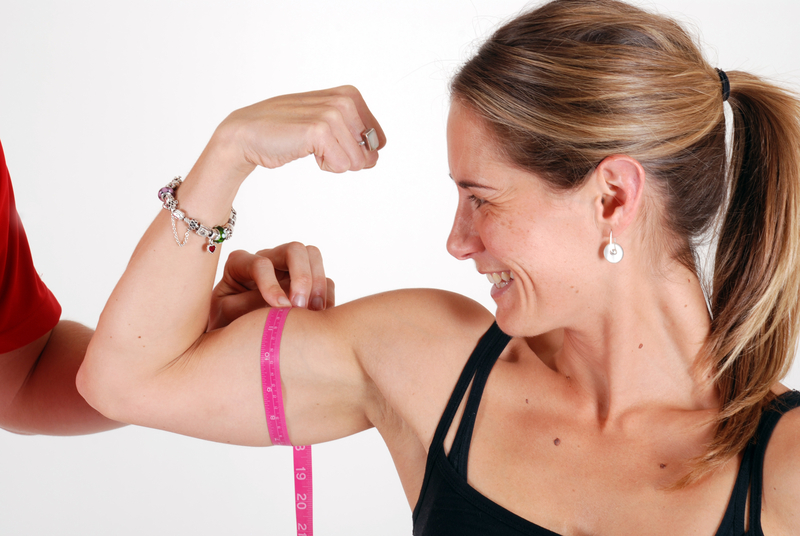The Obesity and Muscle Equation: Why Gaining Muscle Is More Important than Losing Weight

Body recomposition: how are obesity and muscle mass related when it comes to diet and exercise? When you’re overweight, you may think you just need to focus on dieting to lose weight, but if you focus exclusively on that as a goal, you’re doing yourself a grave disservice. Why? Because obesity and muscle are very much part of the same equation. If you want to lose weight effectively, you’ll want to gain muscle. Here’s why.
The Problem with Only Losing Weight
Don’t get fixated on the scale and what it says! If you want to get healthy, you may be tempted to think only about “losing weight.” Some folks get addicted to seeing a lower number on the scale. What’s the problem with that? The issue lies in the fact that “weight” lost exclusively through dieting is often not strictly body fat. Rather, it’s a combination of muscle, fat, and water weight.
Why is this not ideal? First, losing just “weight” means you’re going to become a smaller version of what you are now. You won’t change the shape or tone of your physique. That means if you had a pear-shaped body (i.e., narrow shoulders and wider hips) before you started dieting, after a restricted-calorie diet without resistance training, you’d still have that pear shape, only smaller.
Unfortunately, the bad news doesn’t end there. In the process, you’ll have also lost valuable muscle along with the body fat. (Which you want to avoid at all costs!) If you do nothing to maintain or build your muscle while dieting, you will change your body’s ratio of muscle to body fat (for the worse). Essentially, you’ll have a larger percentage of body fat to muscle mass than you did before you started dieting.
In addition, after such a diet, because you lost muscle mass, your metabolism would be slower. A slower metabolism means that after all that hard work dieting, you will actually have to eat fewer calories than before you started the diet just to maintain your current weight. That’s no fun at all.
Strength and muscle mass are also strong indicators of health and even longevity. For instance, people with higher muscle mass have greater insulin sensitivity, decreased insulin response to carbohydrates, and a lower risk of diabetes. Having more muscle also improves balance and mobility, decreasing the risk of falls or injury as you get older.
On the other side of the equation, having low levels of muscle mass has been associated with lower physical function, decreased quality of life, and higher surgical and post-op complications, longer hospital stays, and shorter survival for those who need hospital care.
Why It’s Vital to Include Resistance Training in the Equation
Where does resistance training come into the obesity and muscle equation? Resistance training is your golden ticket as it helps you build valuable muscle tissue and lose body fat more easily than dieting alone. It also makes it easier to maintain that loss.
Why is muscle so important when it comes to fat loss? Because muscle is metabolically active tissue. That means it needs and burns calories, whereas body fat simply exists and does not require calories.
Think about it: the more muscle you have, the more calories your body needs daily, just to maintain its current weight. That translates to a higher metabolism, meaning you need to eat more food and won’t gain weight. Also, if you do diet, you’ll naturally burn a lot more calories than someone your size who has a higher bodyfat percentage. Bonus: Dieting is easier, quicker, and more effective for people with a higher muscle-to-bodyfat ratio.
Why Protein Is Also So Important
Building muscle is the best way to help your body lose fat on a permanent basis. Give yourself all the advantages by ensuring you get enough healthy, quality proteins in your diet.
Getting “more protein” sounds like a great plan until you realize you don’t know what to do. Well, you’ll have the best and fastest results if you monitor your food intake. If you just eat randomly, you’ll never truly know what’s working for you. On the other hand, if you determine how many grams of protein you’re getting in your meals, you can plan for what you need throughout the day to help you achieve your muscle-building goals.
Ideally, start with 1.0 to 1.5 grams of protein per kilogram of body weight. Optimally, you’ll want to spread this amount out over the course of your day so each meal contains a similar amount of protein. The two most important meals to include plenty of protein appear to be the first one of the day and the last meal before bed. Not only will this help you blunt muscle loss, but you’ll boost your ability to build metabolically active muscle tissue, and you’ll even feel less hungry while dieting.
Don’t Focus on Your Scale Weight
As tempting as it may be to measure your success solely on how much you weigh, remember that the weight you see on the scale is deceptive. It’s only one number in a multi-faceted fitness equation as…
- Muscle is heavy and takes up little space.
- Body fat is lighter yet takes up lots of space.
For example, a volume of muscle will be much heavier than the same volume of body fat. Take two people who weigh 150 pounds. The first person has a higher body fat percentage, whereas the second person has a lot of muscle mass. While they both weigh 150 pounds, the more muscular person will be several sizes smaller and tighter than their less muscular counterpart.
If you’re not focused on the scale weight, then how can you monitor your progress? Choose these methods instead:
- 1. Look in the mirror—monitor how you look from all angles in the mirror over time.
2. See how your clothing fits—to compare most accurately, pick an outfit that’s tight now and try it on every few weeks to watch it start to fit more comfortably as you exercise regularly, get more protein in your diet, and improve diet quality.
3. Take measurements—use a measuring tape and keep track of your waist and hip measurements each week. (Include other areas, too, if you’re motivated).
4. Get your body fat tested—having your body fat professionally measured or investing in skinfold calipers and doing it yourself is a great way to measure your progress. The important takeaway is to always measure with the same method in the same spot for the best results.
5. Take photos—front, side, and back photos taken once a week or month allows you to compare your physique and see your progress. Some people prefer to use a video, moving from all angles, and then pulling single screenshots to compare each week or month.
The issue with losing fat and gaining muscle is that your body is going to primarily focus on one main goal at a time. Losing body fat does not help your body add muscle, but gaining muscle will naturally help your body lose fat in the process. So, clearly, that’s the win-win goal.




 7 Signs Your Body is Seriously Low on Collagen (not just wrinkles)
7 Signs Your Body is Seriously Low on Collagen (not just wrinkles) Health Expert: "Turmeric Doesn't Work (unless...)"
Health Expert: "Turmeric Doesn't Work (unless...)" 3 Warning Signs Your Probiotic Supplement is a Total Waste
3 Warning Signs Your Probiotic Supplement is a Total Waste

